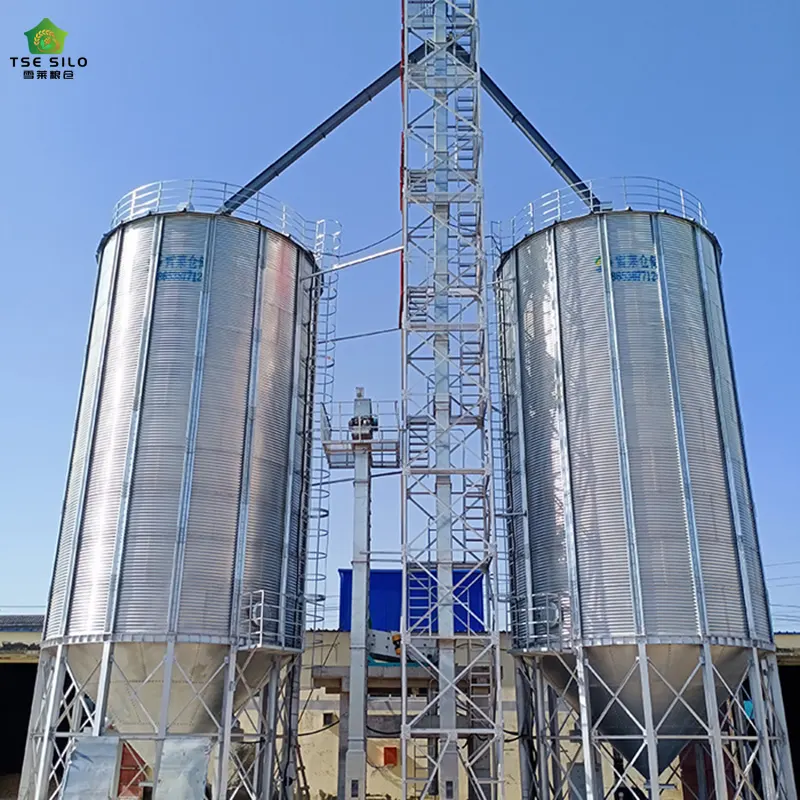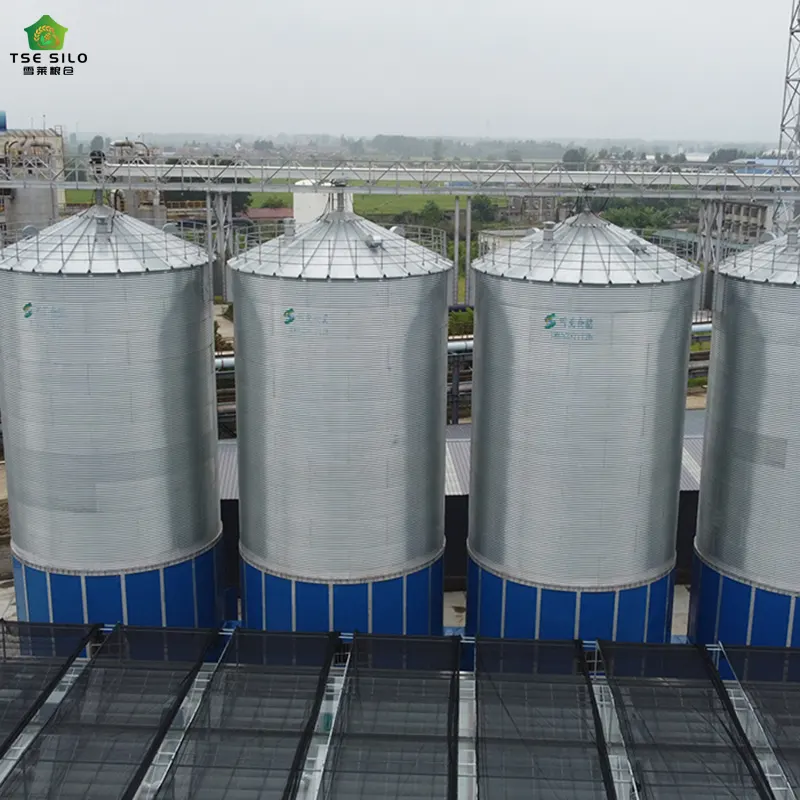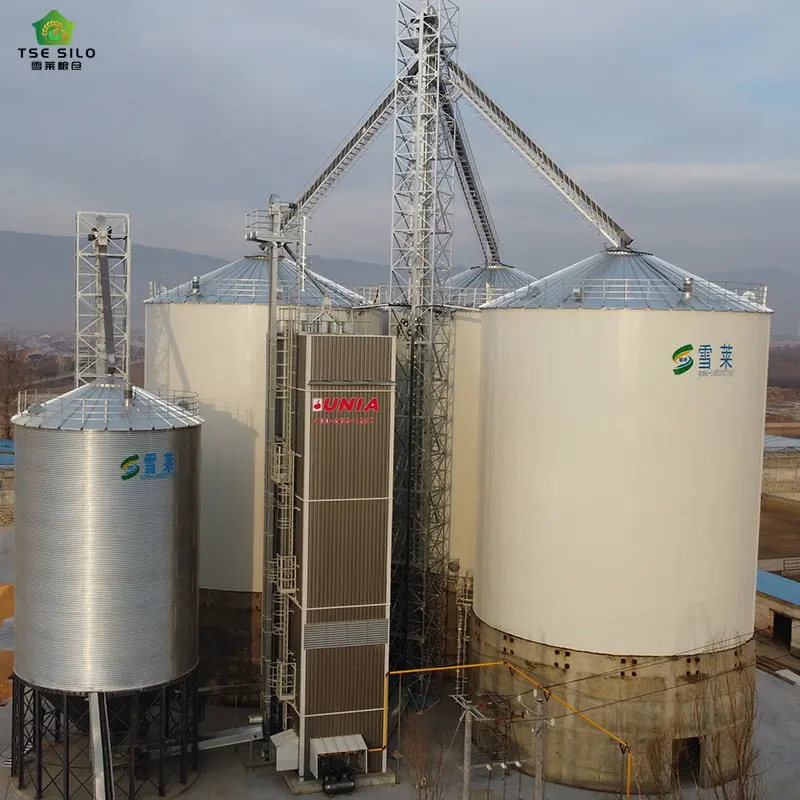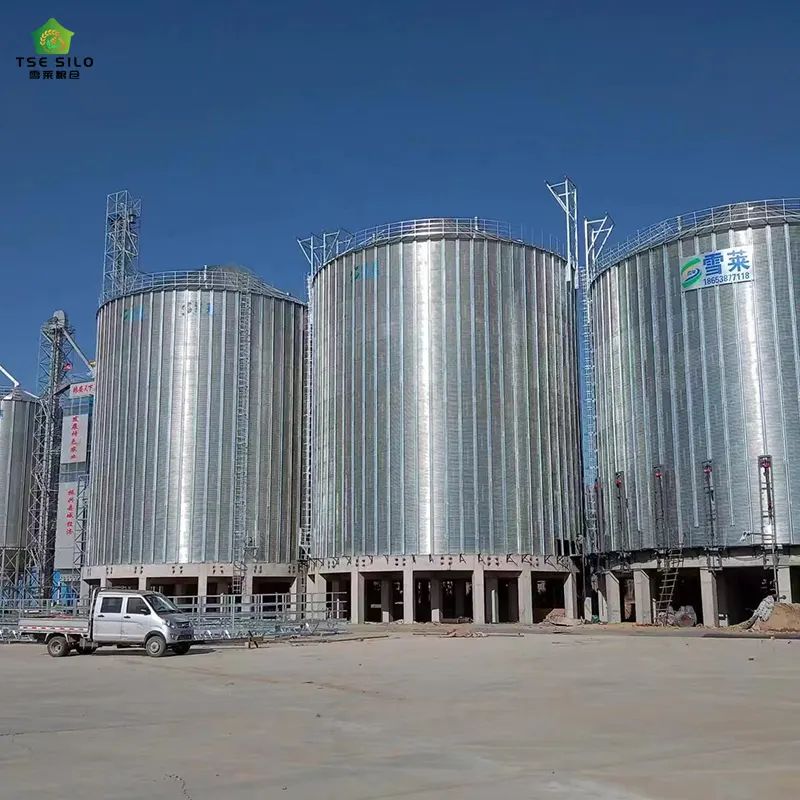


TSE silo is the Leading Supplier for One Stop Solution of Grain Silo System.Large grain steel silos System Producer and Expert.We have built silos with over 10 million tons in 63 countries and regions.
Steel plate warehouses utilize spiral technology, forming continuous 5x-thickness reinforced ribs, providing exceptional load-bearing capacity, seismic resistance, and structural stability. Lifespan reaches 30–40 years, far exceeding traditional concrete warehouses (typically 15–25 years).
Steel plates can be customized for corrosion/abrasion resistance (e.g., zinc-coated or stainless steel), ideal for storing cement, chemicals, or grains. Traditional warehouses (wood/concrete) lack this flexibility and degrade faster in harsh environments.


Automated spiral bending technology enables rapid assembly (5 meters/minute), reducing construction time by 50–70% compared to concrete pouring. No scaffolding or heavy machinery is required.
Steel warehouses weigh 1/6 of concrete equivalents, slashing foundation and material costs. Total project costs are 20–40% lower due to reduced labor and faster completion.
Customizable diameters/heights (10–80 meters) and minimal inter-warehouse spacing (0.5 meters) maximize storage density. Traditional warehouses require larger footprints for equivalent capacity.
Steel warehouses seamlessly incorporate IoT sensors (temperature, level monitoring), automated retrieval systems, and centralized control. Traditional warehouses rely on manual management, increasing error rates by 15–30%.
Precision joints achieve near-perfect airtightness, critical for cement, fly ash, or food grains. Traditional warehouses often suffer from moisture ingress and spoilage.
Steel pallets (used in steel warehouses) offer superior load capacity, 100% recyclability, and resistance to pests/moisture—outperforming wooden pallets common in traditional settings.
Higher upfront material costs; vulnerable to corrosion if poorly maintained; requires technical expertise for automation systems.
Labor-intensive operations (e.g., manual inventory counts); low scalability; 30–40% space underutilization; frequent maintenance for wood/concrete structures.
Steel is 100% recyclable, reducing long-term waste. Energy-efficient designs (e.g., natural ventilation integration) cut operational emissions. Traditional wood/concrete warehouses generate higher lifecycle waste.
Steel warehouses require periodic anti-corrosion treatments but have lower repair frequency. Traditional warehouses face cracks (concrete) or rot (wood), demanding costly fixes.


| Scenario | Preferred Warehouse | Rationale |
| Bulk Powders (cement, grains) | Steel Plate | Airtightness preserves quality; high vertical storage density. |
| High-Turnover Goods | Modern Traditional + WMS | Flexibility for diverse SKUs; WMS boosts accuracy. |
| Hazardous Materials | Steel Plate + Special Coating | Corrosion resistance; containment safety. |
| Budget-Constrained | Basic Traditional | Lower initial investment for stable, low-volume storage. |
Future Trends: Hybrid models (e.g., steel structures with AI management) are emerging. Automation reduces steel warehouses' operational costs by 25%, while traditional warehouses adopting WMS narrow efficiency gaps .
This analysis underscores steel plate warehouses' dominance in durability, automation, and specialized storage, whereas traditional warehouses retain niche value for flexibility and low-volume scenarios.
With the development of the times, the construction of large farms is gradually advancing. Once a large farm is built to store grain, it is not realistic to use the original storage method. Therefore, grain silos have become a more suitable choice. The construction of grain steel silos not only makes an important contribution to grain storage, but also has a very high efficiency in the entire grain from harvesting, drying to storage. Today we will explain to you the ten reasons why you can't stop building grain silos.
1.Steel silos are environmentally friendly, and a dust collector can achieve dust-free emissions.
2.Steel silos are convenient for storage, both mechanical and pneumatic.
3.The outbound method and flow of steel silos are relatively intelligent.
4. The energy consumption required for the operation of steel silos is small.
5.The grain silo has a large capacity for storing materials, and the capacity of a single warehouse is as high as 100,000 tons.
6.The service life of grain silos is long, up to fifty years.
7.The maintenance cost of steel silos is low, saving money and effort.
8. Steel silos are widely used and can store various materials, liquid, granular, powdered, etc.
9. Grain silos have good storage effects and can keep materials from deteriorating for a long time.
10.The process layout of grain silos is flexible, free and convenient.
The above are the top ten reasons why you can’t stop building a grain steel silos. I hope the above explanation can be of some help to you when choosing a grain silo in the future.
Written by
Shandong Shelley Grain Steel Silo Co., Ltd
Editor Jin
www.grainstoragesilos.com
WhatsApp : +86-18653877118
Email : shelley@cnshelley.com